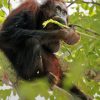
AsianScientist (Jun. 19, 2024) – In June 2022, scientists working in a protected Sumatran rainforest in Indonesia heard a rumble between two orangutans. The next day, they found Rakus, a male orangutan in his thirties, with an open facial wound just below his eyelid. As they observed Rakus over the following days, the scientists from Max Planck Institute and Universitas Nasional Jakarta documented a behavior never seen before. The scientists documented the behavior in a recent paper published in Scientific Reports.
Rakus was spotted feeding on the leaves of Fibraurea tinctoria, a climbing liana plant typically found in the forests of Southeast Asia but rarely eaten by the orangutans in the Suaq Balimbing research area. The scientists soon realized that it was more than just an odd craving for Rakus just three days after his injury.
“Thirteen minutes after Rakus had started feeding on the liana, he began chewing the leaves without swallowing them and using his fingers to apply the plant juice from his mouth directly on to his facial wound,” the authors wrote.
Rakus spent seven minutes applying the plant sap to his wound and used the pulp to cover it when flies started appearing. The scientists observed him feeding on the plant for about half an hour and again for two minutes the next day. They also noted that Rakus was getting more sleep than usual—which helps the wound healing process through the release of growth hormones, protein synthesis and cell division.
By the fifth day after Rakus was first seen applying the plant poultice to his face, his wound had closed with no sign of infection. It fully healed within the next three weeks, leaving only a small scar.
The liana Rakus chose is known for its anti-inflammatory and pain-relieving properties among its other benefits. It belongs to a species of plants often used in traditional medicine to treat conditions like dysentery, diabetes and malaria in humans.
The researchers suggest that the self medication behavior exhibited by Rakus might provide clues about the origins of human wound care—a practice first recorded in a medical manuscript dating back to 2200BC.
“It definitely shows that these basic cognitive capacities that you need to come up with a behavior like this were present at the time of our last common ancestor most likely,” Caroline Schuppli, the senior author of the study based at Max Planck Institute of Animal Behavior told The Guardian. “So that reaches back very, very far.”
While it remains unclear how Rakus learned to treat himself, the study authors suggest it could be through ‘individual innovation’. He may have accidentally touched his wound with the pain-relieving leaf extract and noticed its benefits. Alternatively, he may have picked it up from other orangutans, as these animals are known for learning skills socially.
Next, the researchers plan to keep a close eye on the other orangutans to see if they share similar medical knowledge to Rakus.
“I think in the next few years we will discover even more behaviors and more abilities that are very human-like,” study co-author, Isabelle Laumer from the Max Planck Institute told BBC.
—
Source: Max Planck Institute of Animal Behavior ; Image: Shutterstock
The article can be found at Active self-treatment of a facial wound with a biologically active plant by a male Sumatran orangutan.
Disclaimer: This article does not necessarily reflect the views of AsianScientist or its staff.

